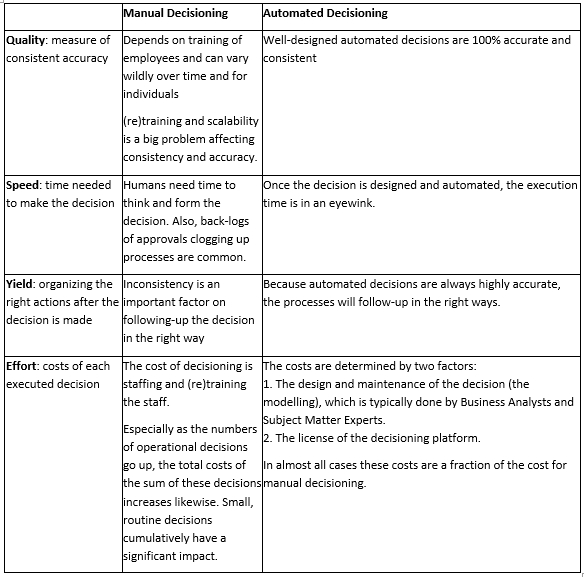Shifting the paradigm: Digital Decisioning
What is Digital Decisioning and why should I pay attention?
Enterprises increasingly are looking how to optimize and digitize their business processes and take advantage of new technology. One aspect that is mostly overlooked are the many thousands of day-to-day operational decisions made inside these business processes. This is where Digital Decisioning adds value by automating these decisions to a high degree, and at the same time vastly improving scalability, consistency and explain ability.
Experts like James Taylor say that Digital Decisioning is at the very heart of the digital transformation, as it integrates the expert’s knowledge with the machine-learning knowledge derived from data.[1] Gartner finds that digital organizations are increasingly looking for ways to automate their operational decisions to make decisions consistent and auditable, to make decisions faster and to save staff costs.[2] Forbes believes that digital decisioning is an emerging technology that both companies and investors find very interesting.[3]
Shift the focus from processes to decisions
In a previous blog post, I asserted that the focus of processes should be shifted to the operational decisions within the business processes, referring to the article The Decision-Driven Organization published in Harvard Business Review.[4]
This research pointed out that the decisions themselves are where value is added, which in turn determines the businesses prosperity. Four key parameters were shown to be critical:

With Digital Decisioning and decision automation, the subject matter expert (SME) contributes his or her insights into how the decision must be made, effectively becoming the supervisor of the decisions and orchestrator of the machine. The business analyst provides the knowledge and technology to organize, elicit and structure the decision model. The machine then merely executes the decision.
Digital Decisioning is at the very heart of the digital transformation, as it integrates the expert’s knowledge with machine-learning knowledge derived from data.
Combine human insights with insights from data
Once the focus on processes has been shifted to decisions, digital transformation can become a reality. According to Forrester, “Digital transformation rests on two pillars - automation and insights. That is precisely the sweet spot of digital decisioning platforms (DDP) - automate all digital decisions with centralized decision logic informed by augmented (human and Ai) insights.” [5]
DDPs effectively connect the dots between quality, speed, yield, and effort in real time — by combining human insights (derived from regulations and experience) with data insights (derived from analytics and machine learning). DDPs play a very important role: separating the business logic from the business processes, the application itself and from code. They also make the decision results available for use in processes and applications, effectively centralizing decisioning.
As Forrester puts it, “[DDPs] streamline and govern digital decision logic authoring, analytics, and execution, so you don’t have to fight an uphill battle to manage business rules and/or decision logic buried in spaghetti code.” [6]
Gartner recommends an integration of different techniques, such as rule-based (expert knowledge) combined with analytics, machine learning and other AI techniques (data knowledge). The result is a continuous business where real-time digital decisioning enhances the operational business decisions.[7]
Conclusion
Digital Decisioning changes how we perceive business process (re)design, business architecture, and the application architecture, enabling a deep digital transformation of the enterprise’s DNA. It points the way to increasing the health and prosperity of the enterprise in the digital and interconnected world. By utilizing digital decisioning platforms and modeling operational decisions, enterprises can create valuable digital assets, reduce risk and secure their digital future.
References
1/Blenko, M. W., Mankins, M., & Rogers, P. (2010). The Decision-Driven Organization. Retrieved from Harvard Business Review: https://hbr.org/2010/06/the-decision-driven-organization
2/Gualtieri, M., & Evelson, B. (Q3 2020). Now Tech: Digital Decisioning Platforms, Q3 2020, Forrester’s Overview Of 24 Digital Decisioning Platforms Providers. Forrester.
3/Kalmijn, P. (2017). Forget processes, think decisions. Retrieved from Atos blog: https://atos.net/en/blog/forget-processes-think-decisions
4/Raghavan, V. (2019). Biometrics, Digital Decisioning, And APIs: These Are The Droids Investment Firms Are Looking For! Forbes. Retrieved from https://www.forbes.com/sites/forrester/2019/04/15/biometrics-digital-decisioning-and-apis-these-are-the-droids-investment-firms-are-looking-for/
5/Schulte, R. (2021). Improve Critical Business Outcomes With Real-Time DataDriven Insights. Gartner.
6/Schulte, W. R., & Sallam, R. (2020). 2 Steps to Improve Business Decisions Using Data and. Gartner.
7/Taylor, J. (2019). Digital Decisioning - using Decision Management to deliver Business impact from Artificial Intelligence.
By Peter Kalmijn, Business Engineer of the Digital Transformation and member of the Scientific Community
Posted on April 7